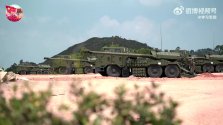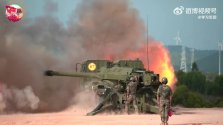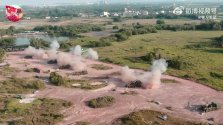I think 370mm is in close to ~ 300km range.PHL-16 130km with 300mm
370mm has 220km range
This dude is a fanboy, dont trust his babbling
You are using an out of date browser. It may not display this or other websites correctly.
You should upgrade or use an alternative browser.
You should upgrade or use an alternative browser.
Self Propelled Gun/Rocket Launcher
- Thread starter FORBIN
- Start date
I think Shilao's podcast kind of talked about this. They mentioned that 300mm is normally used for targets between 100 to 200 km. 370mm is used for farther away targets. So, I think it's probably reasonable to assume that 300mm can reach range of 220 km (that we've been hearing about) in optimal conditions. And that 350 km is probably the range for 370mm version.
They also talked about the need for PCL191 to have all terrain capabilities, since China can't just build roads to places where they want to launch from.
They also talked about the need for PCL191 to have all terrain capabilities, since China can't just build roads to places where they want to launch from.
They also talked about the need for PCL191 to have all terrain capabilities, since China can't just build roads to places where they want to launch from.
I actually think they can
In fact , do the ranges of rocket artilleries exclusively depend on their diameter ?? Can't increase in length (additional boosters) help in this matter ??
Diameter increase volume too isnt it?In fact , do the ranges of rocket artilleries exclusively depend on their diameter ?? Can't increase in length (additional boosters) help in this matter ??
This is a quite complex topic. In general, if we are taking the trajectory as a constant variable to equalize things it mostly depends on burnout velocity and altitude. Burnout velocity is (isp x (ln(fueled mass/final mass)) - (gravity losses + aerodynamic loses). Thus it is about fuel fraction and the propellant. Denser and more efficient propellants are better. Staging helps massively because it allows you to shed empty fuel tanks as you burn fuel saving you from wasting fuel to further accelerate them. Composite bodies, lower payloads, lighter mechanisms and electronics, and ceramic nozzles all help in reducing non-fuel mass. Aerodynamics is of secondary importance since the rocket goes very high but is still important. Increasing the length would increase the ratio of fueled mass/final mass and thus would increase the range. There are limitations to it such as body stiffness and, in larger rockets, thrust-to-weight ratio but is definitely good for range in most cases.In fact , do the ranges of rocket artilleries exclusively depend on their diameter ?? Can't increase in length (additional boosters) help in this matter ??
by78
General
How can a 300mm or close to 300mm diameter rocket artillery reach 500 Km ??
Please stop quoting that fanboy Twitter account.
I wonder if there is a way to block his tweet from being shared on this forum.









